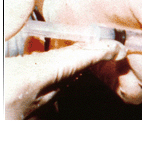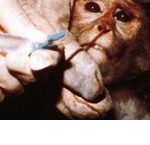Click here to go back.
DANGERS OF GENERALIZING ANIMAL DATA TO HUMANS
Adverse drug reactions (ADR) to medications deemed safe for humans based on animal tests seriously injure more than two million people each year. ADRs kill more than 106,000 Americans every year, more than all illegal drugs combined, and are the fourth leading cause of death in America, behind heart disease, cancer and stroke.1
The Food and Drug Administration (FDA), the government agency responsible for monitoring and ensuring the safety of our food and medications, admits, “ADRs cause one out of five injuries or deaths per year to hospitalized patients.”
A study by the Food and Drug Administration found that 52%--over half--of the prescription medications they approved between 1976 and 1985 caused serious side effects that led to the drugs being withdrawn or relabeled. Each of these medications had been deemed safe after extensive animal testing.2 Medications that had been approved for children were twice as likely to have adverse reactions as other drugs.
When a drug displays no toxicity in animals but causes adverse reactions in humans, this is scientifically referred to as a “false negative.” Thalidomide is considered one of the most harmful examples of a false negative in drug testing. Thalidomide is a drug used in the fifties and early sixties to help diminish morning sickness in pregnant women.
When released to the market, babies of mothers using thalidomide were born with undeveloped or deformed limbs, no limbs, and other deformities. This correlation was observed in humans, not in animals, so the pharmaceutical industry based their decision on animal data and released the drug. As the number of deformed babies born to mothers taking thalidomide increased, scientists tried to duplicate these results in animals. Not surprisingly, it didn’t work, except with New Zealand rabbits when they were given thalidomide doses 25 to 300 times the human dose.
Only after years and more than 10,000 crippled children was the drug finally recalled for this use. The faulty reliance on animal data in the face of conflicting human data was directly responsible for causing healthy babies to suffer awful birth defects that affected their entire lives.
Animal experiments routinely yield false results. Following are a fraction of the numerous occasions in which drugs tolerated by animals went on to harm humans:
In 2004 the arthritis drug Arava was linked to eighty cases of pneumonia and over twelve deaths. Arava sales have been worth $300 million, perhaps the reason the drug hasn’t been recalled.
Merck withdrew its arthritis drug Vioxx in September 2004 after a study found it doubled the risk of heart attacks and strokes; Merck was aware of these dangerous side effects since 2000, the year after the drug was made available.
Hormone supplement prescriptions, including Premarin, have decreased since 2001, when in that year alone these drugs were linked to 14,500 cases of heart disease, breast cancer, stroke and blood clots, and were found to possibly increase the risk of Alzheimer’s or other dementia diseases. In an attempt to keep the money flowing in, the pharmaceutical industry claims hormone supplements are still appropriate for some symptoms, namely hot flashes and thinning bones, both of which can be treated naturally with soy and calcium.
Diethylstilbestrol (DES) is a synthetic estrogen drug that was given to millions of pregnant women to prevent miscarriages, after being found safe and effective in animals. Yet in humans, not only did DES fail to prevent miscarriages, it caused them. It also caused premature births, neonatal deaths, vaginal and cervical cancer in patients' daughters and even adverse effects in patients’ granddaughters. Clinical data had revealed dangers associated with the drug, but it remained on the market for eighteen more years.3,4,5,6
Ticlid has been used as an anti-stroke medication. After causing more than one hundred instances of a life-threatening blood condition, the company still refused to remove their product from the market. Rather, they relabled it.
Isuprel, an asthma medication, was found to be be very toxic to humans at doses dictated by animal studies. Isuprel caused at least 3,500 deaths in the United Kingdom alone. Upon returning to the laboratories and giving elevated doses to animals, researchers were still unable to duplicate these results.7,8,9,10,11,12 An article in Pharmacologist stated, "Intensive toxicological studies with rats, guinea pigs, dogs, and monkeys at dosage levels far in excess of the current commercial metered dose vials... have not elicited similar results." 13
Serevent, used to treat asthma, causes bronchial spasms, the exact condition they are intended to treat. Serevent also causes blood abnormalities, sensory and movement impairment, and serious infections, sometimes resulting in deaths. Its active ingredient, salmeterol, is also found in the drugs Advair Diskus and Seretide.
Another asthma medication, Flovent, was relabeled after causing bronchial complications, some of which were life threatening.
Celebrex, an anti-arthritis medication, was linked to ten deaths and eleven injuries in its first three months on the market. Another anti-arthritis drug, Enbrel, caused infections, tuberculosis and deaths.14 Neither has been removed from the market.
Fialuridine (FIAU), effective in woodchucks was intended to treat hepatitis B, but instead caused liver damage in seven out of fifteen people.15,16 Five died and two needed liver transplants.17 Earlier in vitro tests revealed the likelihood of FIAU harming human patients, but since even 1,000 times the human dose produced no ill effects in mice, dogs or monkeys, researchers continued with the clinical trials, even ignoring patients’ reports of adverse reactions. Later it was learned that dogs have a natural enzyme that deactivates FIAU.
Cylert is used to treat Attention Deficit Hyperactivity Disorder (ADHD) in children. It has caused thirteen children to suffer liver failure, eleven of whom died or received a liver transplant. While Cylert has been recalled in Canada, in the U.S. it has merely been relabeled.
When a drug injures animals but displays no adverse reactions in humans, it is referred to as a “false positive.” These are equally significant in revealing the inaccuracy of animal data because these tests keep potentially useful medications out of our reach; false positives frequently delay or rule out a medication that later is found to be effective and helpful in humans. Following is a small list of examples of such discrepancies between animal and human data:
Penicillin, considered one of the most significant medical advances, was delayed and nearly disregarded altogether because of animal testing. Alexander Fleming first noted penicillin killing bacteria in petri dishes. He then tested in on rabbits. It failed. Rabbits, unlike humans, excrete penicillin in their urine before it can be effective. Fleming put the drug aside, believing it to be useless.18 He later had a very sick patient he felt there was no hope for. With nothing to lose, he tried administering the penicillin. The patient's life was saved, and antibiotics were introduced to the world. H.W. Florey, co-winner of the Nobel Prize for the discovery of penicillin, attempted administering it to a sick cat. The cat died.19 Luckily, Fleming initially tested penicillin on rabbits. Though not effective, at least it was not harmful. Had he tested his preparation on cats, guinea pigs, or hamsters it most likely would have have never been tried on humans, as it is fatal to all of them. 20, 21 Penicillin is also known to cause birth defects in rats. 22
According to Alexander Fleming himself, the man who invented penicillin, "How fortunate we didn't have these animal tests in the 1940's, for penicillin would probably never been granted a license, and possibly the whole field of antibiotics might never have been realized." 23
Acetaminophen, used everyday by Americans, causes kidney failure and death in cats.
Aspirin is the most popular over-the-counter drug and has stood the test of time as being effective and safe for humans, yet aspirin causes birth defects in rats, mice, cats, dogs, guinea pigs and monkeys.
A commonly used antibiotic, Streptomycin, causes fetal deformities in rats.
Isoniazid is used for tuberculosis patients. Isoniazid causes cancer in animals but has been used in humans since 1953 with no carcinogenic effects.
Lasix is used to treat high blood pressure and heart failure. It has been safely used by humans, but was almost shelved because it caused liver damage in mice, rats and hamsters.
Serotonin raises blood pressure in people and dogs, but has the opposite effect in cats.
Morphine is an invaluable, calming painkiller for humans, but in cats and mice it has the opposite effect: it causes maniacal excitement.
Tacromilus is an immunosuppressive drug that helps prevent rejection following transplant surgery. It caused severe toxicity in dogs and was almost rejected before proceeding to clinical trials, which revealed its benefits for human use.
We are left to wonder how many medications which could have saved thousands or millions of lives were forever lost because they were deemed unsafe in animal tests.
1. Journal of the American Medical Association 279 (1998): 1200-5, 1216-7.
2. GAO/PEMD-90-15 FDA Drug Review: Post Approval Risks 1976-1985.
3. NEJM (22 April 1971).
4. Journal of the National Cancer Institute 84 (1992).
5. American Journal of Obstetrics and Gynecology 66 (1953).
6. The Lancet (2 September 1978).
7. Pharmacologist 18 (1971): 272.
8. British Journal of Pharmacology 36 (1969): 35-45.
9. W.H. Inman, Monitoring for Drug Safety (MTP Press: 1980).
10. American Review of Respiratory Disease 105 (1972): 883-890.
11. The Lancet (27 October 1979): 896.
12. Toxicology & Applied Pharmacology 7 (1965): 1-8
13. Pharmacologist 18 (1971): 272.
14. Reuters Health (3 May 1999).
15. Journal of the National Institutes of Health 5 (1993): 33-35.
16. Nature (22 July 1993): 275.
17. NEJM 333 (1995): 1099-1105.
18. Koppanyi & Avery, Clinical Pharmacology & Therapeutics 7 (1966): 250-70.
19. BBC Radio 4 The Discovery of Penicillin (5 August 1981).
20. Am J M Sc 206 (1943): 642-52
21. Proc Soc Exper Biol & Med 91 (1956): 229-30.
22. Lancet 1962: 599-600.
23. ATLA 22 (1994): 207-9.







